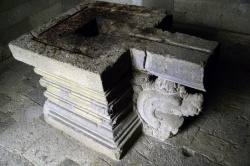Yoni
Yoni (Sanskrit: योनि yoni) is a Sanskrit word with different meanings, most basically "vagina" or "womb". Its counterpart is the lingam. It is also the divine passage, or sacred temple (cf. lila). The word can cover a range of extended meanings, including: place of birth, source, origin, spring, fountain, place of rest, repository, receptacle, seat, abode, home, lair, nest, stable.
In Indian religions
In Hinduism, the ancient Indian texts contain the word yoni in various contexts. In Hindu philosophy, according to Tantra, yoni is the origin of life. The yoni is also considered to be an abstract representation of Shakti and Devi, the creative force that moves through the entire universe.Sacred Sanskrit words, p. 111
In Indian religions according to Vedas and Bhagavad Gita, Yoni is a form of life or a species. There are 84 lakh (8,400,000) yonis total with Manushya Yoni (Human form/human species) as one of them. A human (manushya yoni) is obtained on the basis of good karma (deeds) before which a human goes through various forms of yonis (for example, insect, fish, deer, monkey, etc.). Bad karmas will lead one to be born in rakshasa yoni (evil form). The births and rebirths (the cycle of life) of a human happens in various yonis. A human who achieves the enlightenment (Mokshya) breaks the cycle of reincarnation and adjoins Brahma.
Linga-yoni
The yoni is the creative power of nature and represents the goddess Shakti. The linga stone represents Shiva, and is usually placed in the yoni. The lingam is the transcendental source of all that exists. The linga united with the yoni represents the nonduality of immanent reality and transcendental potentiality.
Worship
In Shaktism the yoni is celebrated and worshipped during the Ambubachi Mela, an annual fertility festival held in June, in Assam, India, which celebrates the Earth's menstruation. During Ambubachi, the annual menstruation course of the goddess Kamakhya is worshipped in the Kamakhya Temple. The temple stays closed for three days and then reopens to receive pilgrims and worshippers. It is one of the most important pilgrimage sites in the world, attracting millions of visitors each year, particularly for Ambubachi Mela which draws upwards of 100,000 pilgrims per day during the 4-day festival. Darshan at this temple is performed not by sight as in most temples, but by touch. There is a large cleft, a yoni in the bedrock moistened by water flowing upward from an underground spring, generally covered by cloths and ornate chunris, flowers, and red sindoor powder. Devotees and pilgrims offer items for worship directly to the goddess, then touch her and drink water from the spring. They then receive a tilak and prasad by the attending priest. After completing darshan, devotees light lamps and incense outside the temple. Like other temples, worship is not considered complete until the temple is circumambulated clockwise.
In archeology
Lingam-yonis have been recovered from the archeological sites at Harappa and Mohenjo-daro, part of the Indus Valley Civilization. There is strong evidence to support cultural continuation from the Indus Valley Civilization (Harappan; Indus-Sarasvati) to Vedic and modern Hindu practices.
Other uses
Yoni Mudra is a principle in meditation used to reduce distraction during the beginning of yoga practice.
In the Thai language the sharp corner of the eye closest to the nose is referred to as "Yoni Tha" where "Tha" means the eye.
Yoni is the vulva in texts such as the Kama Sutra.
A child is born from a yoni of stars - constellations that prevailed during the child birth. The Aryans had identified some 50,000 astrological yonis that favour a child's birth.
The Aryans used the term yoni in agriculture. A 'fertile yoni' meant a good harvest of crops.
The yonic symbol has also been used by artists to portray feminism in art.



